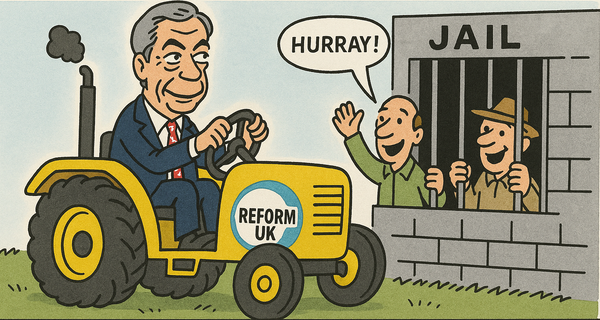Why we need new gatekeepers to counter AI slop
In less than two years, AI content is polluting search results and social networks. We need a new wave of curators to counter this.

Years — possibly decades — ago, I saw Mat Morrison talking about the tidal wave of crap that digital had unleashed on our limited attention. (I’m sure I blogged about it, but I can’t find the post right now.) That wave seems positively quaint, when compared to the absolute tsunami of slop that AI has unleashed on us.
One example that’s been circulating in recent weeks: Google Images results for “baby peacock” were dominated by AI images. One could make a compelling case that, just as the web destroyed the old news gatekeepers of the past, AI is doing that to the new gatekeepers. Google is increasingly polluted by AI slop, diminishing its usefulness. Boomers are sharing AI images on Facebook.
Some platforms are actively leaning into this. Instagram used to be where you went to see images from friends and contacts. Now, if Meta has its way, it’ll be full of AI images:
When you come across an “Imagined for You” image in your feed, you’ll see options to share the image or generate a new picture in real time. One example (embedded below) shows several AI-generated images of “an enchanted realm, where magic fills the air.” But others could contain your face… which I’d imagine will be a bit creepy to stumble upon as you scroll.
So, yes, they’re trying to drive up engagement by auto-generating AI images for you to share. Slowly, the reality of your friends vanishes, drowned in that wave of AI slop.
Algorithmic systems are failing to separate the synthetic from the human. And so, rather than fix that, the platforms are embracing it. I'm not sure this is a future many of us are excited about.
The return of the old gatekeepers?
So, what happens now? What if you would rather not spend all your time consuming the AI generated synthetic media?
This is an issue Charles Arthur has been poking at in his Social Warming newsletter, based on a question from a reader: would the news media make a comeback as gatekeepers?
Spoiler: Arthur is… unconvinced. And for good reasons. For one, do people have the media literacy to discern what’s a good site from a fake one?
It’s all just a click or a URL away, and you might need some skill to tell the difference between a junk site and a site that just looks like junk.
Evidence suggests people aren’t great at this… Plus, of course, the role of the old news brands has been fundamentally changed by the rise of the new gatekeepers.
The other problem with hoping for the return of the gatekeepers is that too many companies have now inserted themselves as gatekeepers in the media ecosystem. Google is the biggest of the beasts, but Facebook/Instagram/Threads also has a big role to play, while Twitter is a sort of circular economy all its own, with people making up “news” and using big accounts to spread it around.
Disruption of the new gatekeepers
This is where I start to part company with Arthur a little. Those are the new old gatekeepers he’s talking about, because they are being disrupted by AI. That’s why they’re so eagerly embracing it, as they can see the existential risk to them in what’s happening if they don’t. But what they’re doing is risky, and they could end up alienating users rather than keeping them.
Google AI overviews are not always terribly useful. I had a whole series of them last night when investigating something for a potential article, and not one of them was useful. And, in one case, it was actively misleading. The platforms injecting AI into their offerings is a gamble — and it might backfire.
And it’s happening in the context of more and more people backing away from these gatekeepers, shunning the centralised social media platforms, and moving into more closed, controlled community spaces like WhatsApp and Discord. People are already rejecting the current gatekeepers.
The new new gatekeepers
Now, some platforms are actively trying to make themselves new gatekeepers, by understanding and acknowledging the new reality. For example, Substack, where Arthur is writing, which is trying really hard to make itself a place for communities, via comments, Notes, chats and live video.
Arthur again:
The reality is that “news” is now found on sites like Substack: you can spend as much money subscribing to writers here as you could have in the past on newspapers. There’s as much free content—perhaps even more—than you’d have got in the past. Newspapers have exploded under the stress of the internet, and the useful pieces are now spread all over the web. Your challenge is generally to find them, not to get past a gate to them.
And yes, this is key. The wounding of the new gatekeepers isn’t opening the way for the old ones to return. It’s creating an opportunity for something new to emerge.
The new curators

What tools like Substack and Ghost are enabling is the emergence of a new form of expertise-based curator. Yes, I know curation and aggregation got a deservedly bad name in recent years, as some publishers used these names to disguise the fact that they were straight up ripping off and rewriting others’ stories.
But the idea of the trusted curator, who readers support, and who can cut through the AI noise to find the human value has potential. Why? People, frustrated with AI slop, are beginning to see the need for them.
For example, Manuel Moreale:
I was listening to a podcast episode the other day while I was driving and in there there was a thought that stuck with me: the idea that the web is moving from a creator economy to a curator economy. With a web flooded with AI generated slop and the platforms themselves encouraging it, the role of curators is gonna become more and more important.
The trick, of course, is figuring out the discovery piece. How can people find these emergent curators, even as the existing gatekeepers disappear under a today wave of slop? And that might come down to something as old-fashioned as human recommendation and promotion. Substack, of course, has built its entire platform around trying to allow its writers and curators to find audiences, and has picked up an almost cult-like following for it.
Let a thousand curators blossom
But the answer will be about more than yet another platform. Again, we’re moving towards a world where the old social networks are just booming social media, places to consume content. The networking is disappearing into closed groups and chats, the sort of thing we used to call “dark social”.
We’re going through a periodic cyclical change, where people back away from mass social media, and move towards distributed social spaces. What will emerge through this process is anyone’s guess,
But I’ll have a shot at it now, because I've never been afraid of making a fool of myself in public. 😉
We’re going to see a split between two main forms of trusted media. There will be a handful of truly global trusted news brands, that act as curators of their own vast volumes of content, and not much else. And there will be a huge and diverse ecosystem of niche curators and creators of various sizes, who will build trusted relationships with their audiences, and act as nano-gatekeepers, ones people actively choose and value.
And that will be the status quo for a while. But not forever. The digital wheel always turns back towards centralisation…





